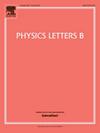Probing α-clustering in 9Be via complete fusion and elastic scattering measurements
IF 4.3
2区 物理与天体物理
Q1 ASTRONOMY & ASTROPHYSICS
引用次数: 0
Abstract
The intrinsic structure of the 9Be nucleus has been probed by virtue of its influence on reaction dynamics in the 9Be+110Pd collision. Extensive measurements of the complete fusion excitation function have been undertaken across the Coulomb barrier, in conjunction with the measurement of the elastic scattering angular distribution at a few overlapping incident energies. A unified treatment of both processes is carried out by employing 3-body and 4-body Continuum Discretized Coupled Channels calculations, which exclusively cater to the dynamical features of the collision contingent on the low threshold for dissociation of 9Be into either two or three clusters. A synergy between the complete fusion and elastic scattering measurements across different incident energies is attained when the pivotal description of 9Be as α+α+n configuration is invoked. While the elastic scattering angular distribution is observed to be sensitive to the continuum couplings, the fusion excitation function is primarily influenced by the structure of 9Be in its ground state. The α+α+n picture further reveals an absence of above-barrier fusion suppression when compared with the Universal Fusion Function, in contrast to the commonly reported signature for reactions induced by the 9Be projectile.
求助全文
约1分钟内获得全文
求助全文
来源期刊

Physics Letters B
物理-物理:综合
CiteScore
9.10
自引率
6.80%
发文量
647
审稿时长
3 months
期刊介绍:
Physics Letters B ensures the rapid publication of important new results in particle physics, nuclear physics and cosmology. Specialized editors are responsible for contributions in experimental nuclear physics, theoretical nuclear physics, experimental high-energy physics, theoretical high-energy physics, and astrophysics.
 求助内容:
求助内容: 应助结果提醒方式:
应助结果提醒方式:


